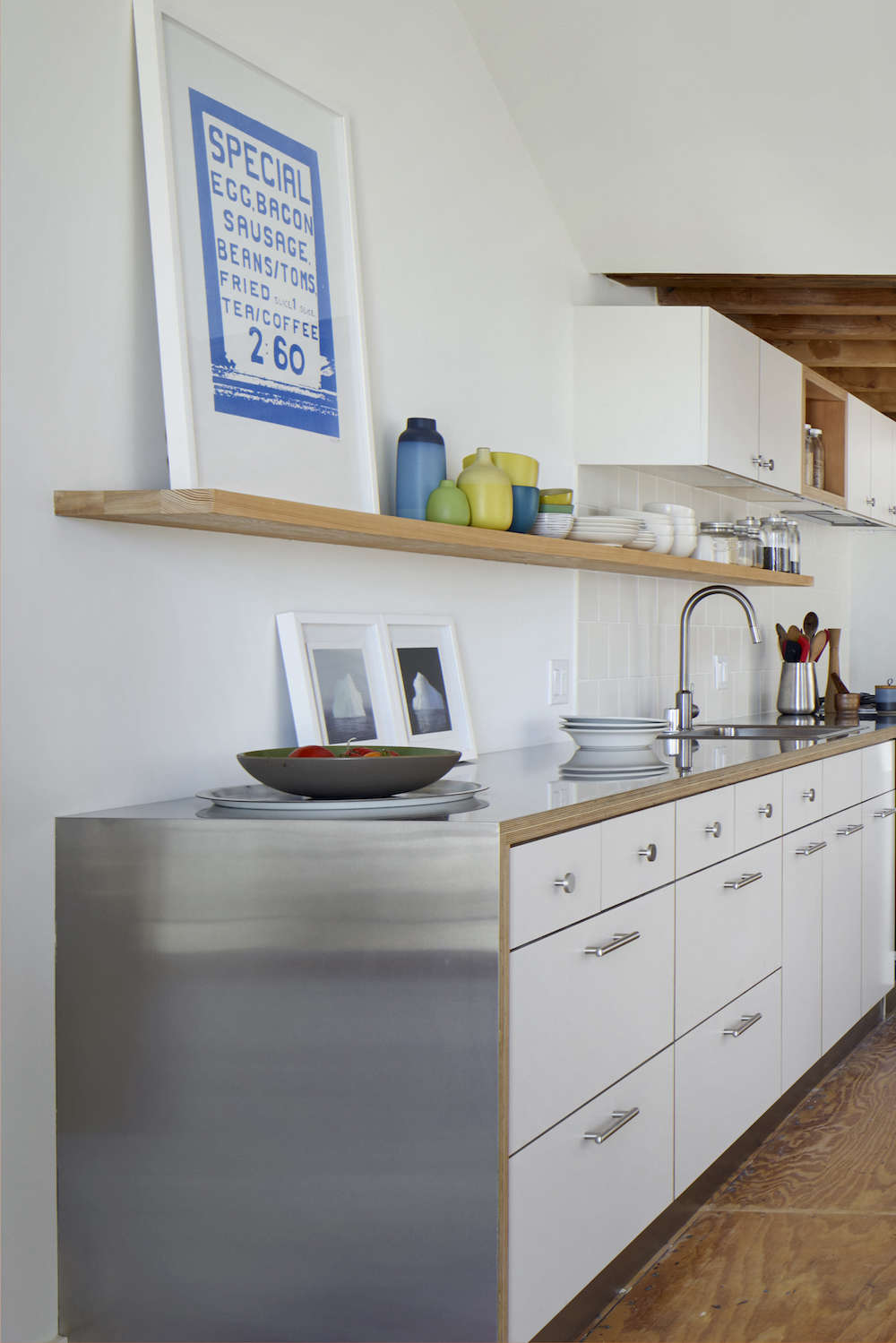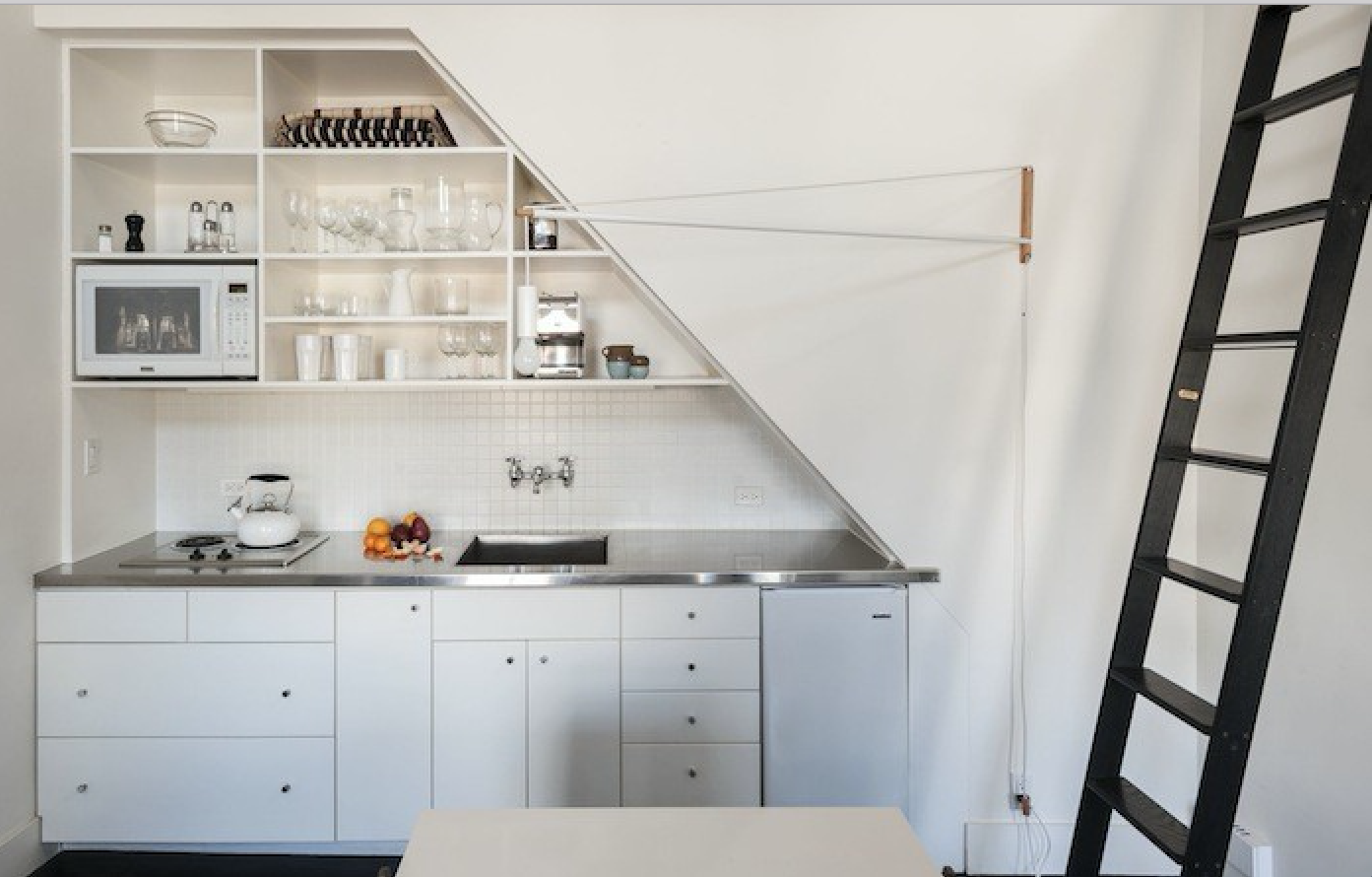Look inside any restaurant kitchen and you’ll see stainless steel worktops everywhere. Impervious to heat and virtually indestructible, stainless steel is a countertop material designed for serious cooks. (And, in recent years, stainless has infiltrated just about every surface in the home kitchen.) Does this translate into the ideal work surface for you? Read our primer to fully understand stainless.
Above: When transforming a Santa Monica penthouse on a budget, LA architect Oonagh Ryan chose stainless steel counters: “It’s a really terrific countertop from a cost, durability, and maintenance perspective. And it only looks better with age and use,” she says. See Kitchen of the Week: A Budget Kitchen Rehab in a Santa Monica Rental Loft.
What is stainless steel?
Stainless steel is a steel that contains a minimum of 10.5 percent chromium, which makes it resistant to rust and corrosion. It comes in various grades that depend on the additional metal alloys that are mixed in. Type 304, or austenitic steel, is known as food-grade stainless because food and hot cooking tools can be safely placed directly on its surface. The most commonly used stainless for countertops, Type 304 contains a high level of chromium and nickel, which increases its stain and heat resistance.
Another important detail to know: Stainless steel is manufactured in a variety of gauges (14 to 20 are the typical gauges and represent the thickness of the sheet—14 gauge is 1.4 millimeters thick—and subsequently its strength). The lower the gauge, the thicker the steel; the thicker the steel, the stronger your counter will be for handling weighty equipment and heavy use without denting: 16- and 18-gauge steel are the most commonly used thicknesses for residential applications, while 14 gauge is found in many commercial settings.
Should stainless steel be on your countertop shortlist?
Stainless steel has all the qualities needed for an indestructible kitchen worktop. Heat-resistant? Check. Non-staining? Check. Hygienic and easy to clean? Check. It’s a nonporous material that unlike butcher block, concrete, and many natural stones, will not absorb even the toughest of cooking ingredients—which means that stainless doesn’t stain or harbor bacteria. Hot pots and pans can be placed directly on its surface without worry. That said, stainless steel, like many materials, shows scratches, especially if sharp knives and other tools are used directly on it. (And stainless itself will damage knives, so it’s wise to cut on a cutting board.) Most stainless used for countertop applications is brushed, which serves to camouflage small scratches, but, even so, it will patina over time.
Concerned about the cool industrial feel of stainless? It can be paired with other warm countertop materials to soften the look. When I lived in London 10 years ago, my kitchen had hardworking stainless countertops around the stove mixed with butcher block and stone countertops in the prep areas.
Above: Sleek stainless counters add industrial style to minimalist built-in shelving in Strategic Storage in a Minimalist Loft. Photograph by Todd Mason/Halkin Mason Photography.
What are the installation guidelines?
Stainless steel countertops are typically custom fabricated. Sheets of stainless are cut to size specifications and placed on top of a wooden substructure. The sheet is typically wrapped over the edge to achieve the look of a standard countertop or can be cut flush with the wood base. The stainless steel can also be folded and run up the wall to create a backsplash.
Above: An elegant installation solution: Thin countertops in a kitchen by architect Jerome Buttrick have a modern look—and are cheaper than wrapped-edge counters.
What kind of edge profiles are available?
Because stainless countertops are typically custom fabricated, the sheet can be wrapped over the edge in a variety of thicknesses. To get the look of standard countertop thickness, a 1.5-inch side drop is specified, but many variations, from thick to thin, are possible.
Different edge shapes, or profiles, are also available. The most common is an eased square edge; other options include a beveled edge, bullnosed (rounded) edge, or no wrapped edge at all.
Above: Favored in some restaurant settings, the marine edge profile is an option that keeps liquids from running off the counter. Photograph via John Boos & Co.
Above: A detail of the stainless steel countertop in a Brooklyn townhouse kitchen by architects Fernlund + Logan (who have since opened their own offices: Solveig Fernlund Design and Neil Logan Architecture). A signature of the architects is to leave the striped plywood exposed and have the stainless counter rest on top with no edge wrap. See Kitchen of the Week: A Scandi Design in Brooklyn. Photograph by Matthew Williams for Remodelista.
What are the finish options?
Stainless steel counters are available in several finishes: brushed, satin polish, mirror polish, and antique matte to name a few. Brushed finish is the most popular because it looks smooth and soft, and doesn’t show as many fingerprints or scratches as the polished options.
Above: In a revamped 1960s townhouse in Auckland, stainless steel counters and an inset utility sink are paired with a blackened steel backsplash. See Kitchen of the Week: Blackened Steel, Bohemian Style. Photograph by Joanna Wickham.
How do you clean and maintain stainless counters?
Cleaning stainless steel is easy: the nonporous nature of the material means that foods and liquids sit on top of it and are best removed with mild soap and a soft cloth. Fingerprints, too, accumulate on the surface until cleaned. You can use special stainless steel cleaners and polishes to minimize fingerprints, but over time there’s no avoiding some signs of use and abuse. Mirrored polish stainless typically requires periodic polishing to maintain its high luster. Specialty Stainless offers a useful Re-polishing Stainless Steel Primer.
Above: In a kitchen by Murphy Burnham & Buttrick, the architects used a very fine brush-finished stainless. While pleasing to the eye, the finish requires regular maintenance—the owners apply an aerosol stainless steel cleaner with a cotton cloth—to keep it fingerprint-free and polished. Take a tour and hear from the architects about The Twice-Designed New York Loft. Photograph by Ty Cole.
How much do stainless steel countertops cost?
Not a budget choice, stainless steel countertops run between $75 and $150 per square foot installed. Prices vary depending on site-specific needs, the level of customization, your location, and the gauge of the stainless sheeting used. This is comparable to quality natural stone counters and more expensive than butcher block.
One way to cut costs dramatically is to use prefabricated restaurant stainless steel work tables and counters available through restaurant supply companies, such as the Web Restaurant Store. There are fewer options in terms of sizing, but it can be an appealing way to integrate a stainless work surface into an existing kitchen or replace counters with a non-built-in alternative.

Above: A stainless-steel-appointed kitchen with a rustic wood floor at the Brücke 49 Hotel Pension in the alpine spa town of Vals, Switzerland.
Above: For an affordable compact kitchen in her own guest quarters in Brooklyn, architect Elizabeth Roberts sourced a stainless countertop from a Bowery restaurant supply store and paired it with Ikea Applad Cabinets (no longer available). See the full project on pages 76-91 of the Remodelista Book. Photograph by Matthew Williams for Remodelista.
Stainless Steel Countertop Recap
Pros
- Heat resistant—a great choice next to stoves.
- Hygienic and easy to clean.
- Nonporous and won’t stain or rust.
- Practically indestructible.
Cons
- Can get dents and scratches, particularly lower gauge stainless steel.
- Shows fingerprints (though they clean off easily).
- Can be loud when setting pots and pans and other equipment on the counter.
- Aesthetically cold.
- Not for the budget-minded—unless you go with prefabricated stainless steel tables and counters.
Researching new countertops? Read 10 Easy Pieces: Remodelista Kitchen Countertop Picks and 10 Favorites: Architects’ Budget Countertop Picks. For more specifics on the subject, see our Remodeling 101 posts:
- Remodeling 101: Soapstone Countertops
- Remodeling 101: Butcher Block Countertops
- Remodeling 101: Concrete Kitchen Countertops
- Remodeling 101: Marble Countertops
- Remodeling 101: Corian Countertops (and the New Corian Look-Alikes)
Finally, get more ideas on how to evaluate and choose your kitchen countertop in our Remodeling 101 Guide: Kitchen Countertops.
N.B.: This post is an update; the original story ran on February 27, 2014.
Frequently asked questions
What are stainless steel countertops?
Stainless steel countertops are made of a durable, non-porous material that is resistant to heat, stains, and bacteria. They are popular for their sleek and modern look, as well as their versatility in terms of design and application.
How do I clean my stainless steel countertops?
Stainless steel countertops can be cleaned with warm water and soap, or with a specialized stainless steel cleaner. Avoid using harsh or abrasive cleaners that can scratch the surface or cause discoloration. Dry the countertops thoroughly after cleaning to prevent water spots.
Can I cut or chop directly on my stainless steel countertop?
While stainless steel is a durable material, it is not recommended to cut or chop directly on the surface. This can damage the countertop and dull your knives. Use a cutting board to protect both your countertop and your knives.
Are stainless steel countertops expensive?
Stainless steel countertops can range in price depending on the thickness and quality of the material, as well as the size of the countertop and any special features or accessories. They are generally considered a more expensive option compared to other types of countertop materials.
Can I install stainless steel countertops myself?
Stainless steel countertops can be installed by a professional installer or by a DIY homeowner with some experience in construction and installation. It is important to carefully measure and cut the material to fit your space, and to use proper tools and techniques to ensure a secure installation.














Have a Question or Comment About This Post?
Join the conversation